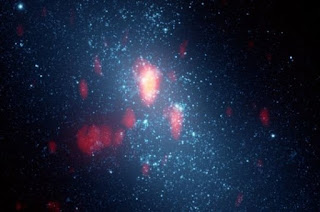add
Tuesday, January 12, 2016
Globular bunches could have interstellar human advancements
Globular star bunches are uncommon in practically every way. They're thickly pressed, holding a million stars in a ball just around 100 light-years crosswise over by and large. They're old, going back nearly to the conception of the Smooth Way. Furthermore, as indicated by new research, they likewise could be exceptionally great spots to search for space-faring civic establishments.
Globular star bunches like this one, 47 Tucanae, may be fantastic spots to look for interstellar human advancements. Their swarmed nature implies savvy life at our phase of mechanical headway could send tests to the closest stars.
Globular star groups are uncommon in verging on each way. They're thickly stuffed, holding a million stars in a ball just around 100 light-years crosswise over all things considered. They're old, going back just about to the conception of the Smooth Way. Furthermore, as indicated by new research, they likewise could be phenomenally great spots to search for space-faring human advancements.
"A globular bunch may be the primary spot in which savvy life is recognized in our system," says lead creator Rosanne DiStefano of the Harvard-Smithsonian Community for Astronomy (CfA).
DiStefano displayed this exploration today in a public interview at a meeting of the American Galactic Culture.
Our Smooth Way world hosts around 150 globular groups, the greater part of them circling in the galactic edges. They framed around 10 billion years prior by and large. Therefore, their stars contain less of the overwhelming components expected to develop planets, since those components (such as iron and silicon) must be made in before eras of stars. A few researchers have contended this makes globular group stars less inclined to host planets. Truth be told, one and only planet has been found in a globular bunch to date.
Nonetheless, DiStefano and her partner Alak Beam (Tata Organization of Key Examination, Mumbai) contend this perspective is excessively critical. Exoplanets have been found around stars one and only tenth as metal-rich as our Sun. Keeping in mind Jupiter-sized planets are discovered specially around stars containing more elevated amounts of substantial components, research finds that littler, Earth-sized planets demonstrate no such inclination.
"It's untimely to say there are no planets in globular groups," states Beam.
Another concern is that a globular group's swarmed surroundings would debilitate any planets that do structure. A neighboring star could meander excessively close and gravitationally upset a planetary framework, throwing universes into cold interstellar space.
On the other hand, a star's tenable zone - the separation at which a planet would be sufficiently warm for fluid water - differs relying upon the star. While brighter stars have more far off tenable zones, planets circling dimmer stars would need to group much closer. Brighter stars likewise live shorter lives, and since globular groups are old, those stars have ceased to exist. The overwhelming stars in globular groups are weak, extensive red smaller people. Any conceivably tenable planets they host would circle close-by and be moderately protected from stellar communications.
"When planets structure, they can get by for drawn out stretches of time, much more than the present age of the universe," clarifies DiStefano.
So if tenable planets can shape in globular bunches and make due for billions of years, what are the outcomes forever would it be a good idea for it to advance? Life would have plentiful time to wind up progressively complex, and even conceivably create insight.
Such a development would appreciate an altogether different environment than our own. The closest star to our nearby planetary group is four light-years, or 24 trillion miles, away. Interestingly, the closest star inside of a globular bunch could be around 20 times closer - only one trillion miles away. This would make interstellar correspondence and investigation essentially less demanding.
"We call it the 'globular group opportunity,'" says DiStefano. "Sending a telecast between the stars wouldn't take any more than a letter from the U.S. to Europe in the eighteenth century."
"Interstellar travel would take less time as well. The Voyager tests are 10 billion miles from Earth, or one-tenth to the extent it would take to achieve the nearest star on the off chance that we lived in a globular bunch. That implies sending an interstellar test is something a progress at our innovative level could do in a globular group," she includes.
The nearest globular bunch to Earth is still a few thousand light-years away, making it hard to discover planets, especially in a group's swarmed center. In any case, it could be conceivable to recognize traveling planets on the edges of globular bunches. Space experts may even spot free-gliding planets through gravitational lensing, in which the planet's gravity amplifies light from a foundation star.
An additionally interesting thought may be to target globular bunches with SETI seek techniques, searching for radio or laser telecasts. The idea has a long history: In 1974 cosmologist Straight to the point Drake utilized the Arecibo radio telescope to telecast the first think message from Earth to space. It was coordinated at the globular group Messier 13 (M13).
Headquartered in Cambridge, Mass., the Harvard-Smithsonian Community for Astronomy (CfA) is a joint coordinated effort between the Smithsonian Astrophysical Observatory and the Harvard School Observatory. CfA researchers, sorted out into six exploration divisions, ponder the starting point, development and extreme destiny of the u
Subscribe to:
Post Comments (Atom)

No comments:
Post a Comment